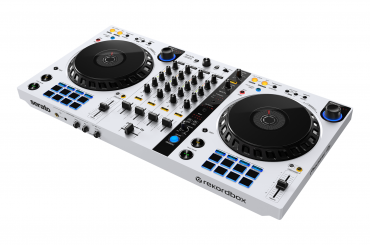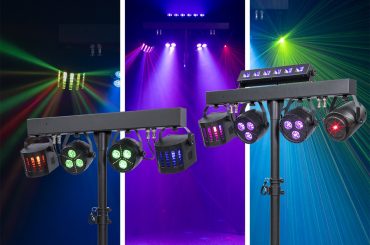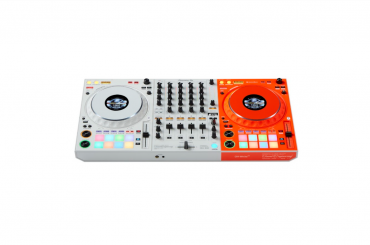The Roland DJ-808: imagine a DJ controller and software set-up that provides four decks’ worth of the usual DJ capabilities, but pairs it with some of the music industry’s most iconic drum machines.
Here’s why this is a big deal: It seems obvious that for many years now, there’s been a gradual blurring of the line between what constitutes a club DJ and a performing artist.
Functions common to virtually all modern DJ applications—looping, sampling, jumping around cue points, and otherwise manipulating source material—have allowed club DJs and others to perform what is essentially real-time remixing: chopping-up, rearranging and manipulating material in ways that DJs a decade ago could scarcely dream about. And both DJ software and hardware controllers have attempted to bring more production elements to the table to enable even more flexibility with this on-the-fly remixing.
But imagine for a moment a set-up that takes all of those capabilities, and stretches it even farther — that’s the Roland DJ-808, providing four decks’ worth of the usual DJ capabilities, but pairs it with some of the music industry’s most iconic drum machines.
Read More: A review of Roland DJ-202 and DJ-505 controllers
Imagine that this same controller throws in some state-of-the-art pitch-and-timing adjustment capabilities, enabling you to warp your source material in entirely new ways. And then imagine that—just for good measure—a vocal-transformation-effects engine was put on-board, allowing you to have a little creative fun with a microphone alongside everything else.
Oh, and one more thing: Let’s just toss in some cool new ways to synchronize your DJ performance with other instruments, or a full-blown DAW (digital audio workstation).
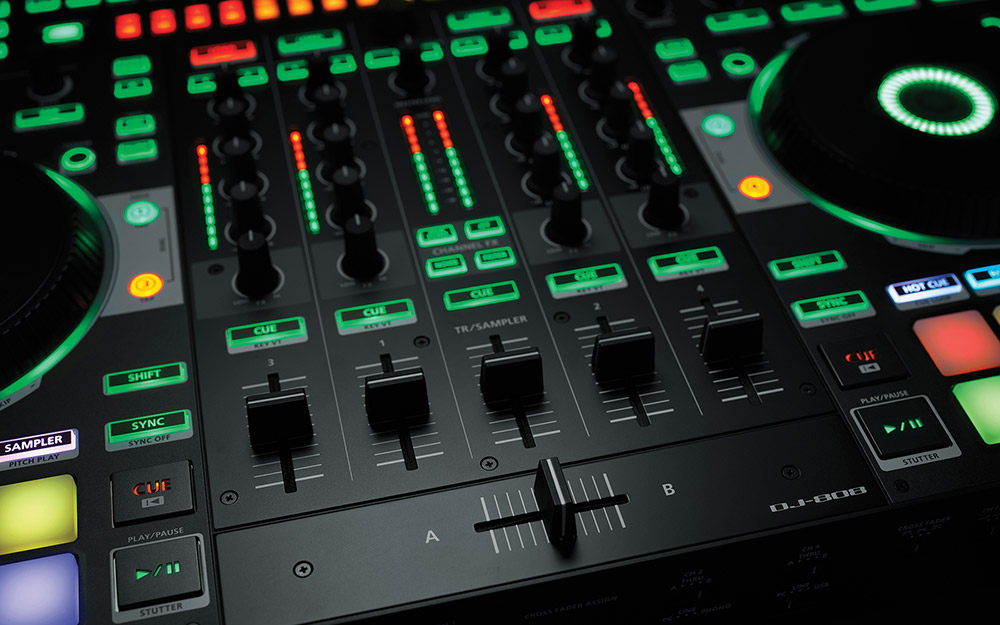
Well, you don’t need to use your imagination anymore. That DJ controller and software bundle is here in the form of the new Roland DJ-808, a hardware controller for Serato that brings some interesting innovations to the fore.
Maybe you’re thinking right about now, “Wait—Roland?” So, yes, the iconic music hardware company has introduced its first entrée into the DJ-controller market, and they’ve clearly aimed to make an impact.
The Basics: Let’s start with all the stuff you’d expect of a high-end DJ controller designed for Serato. First, obviously, is Serato itself; the controller unlocks the full Serato DJ application. I’ll come back to this later, but you also get a certificate you can redeem online to receive Serato’s Pitch ’N Time DJ Expansion Pack, which normally retails for $29.
The iconic music hardware company has introduced its first entrée into the DJ-controller market, and they’ve clearly aimed to make an impact.
On the hardware side, there are four decks’ worth of digital DJ control. There are faders and gain knobs. There’s 3-band EQ knobs just where you’d expect to find them. There’s a crossfader, should your style dictate that you need one. And in an approach that’s very common among Serato controllers in particular, you have eight multifunction pads that control various “extras” (like the new Pitch Play functions and the TR mode that lets you play the TR from pads). And yes, of course, there are two nicely sized rotary encoders with the expected transport buttons, with pitch faders nearby.
As you’d probably expect from hardware sporting the Roland name, the build quality is top notch. Knobs and faders have a perfectly balanced feel, and the jog wheels in particular are a pleasure to use. And while the unit itself is fairly big, it’s not terribly heavy. Even with an appropriate case to protect it, you’re not going to be pulling any shoulder muscles toting it around.
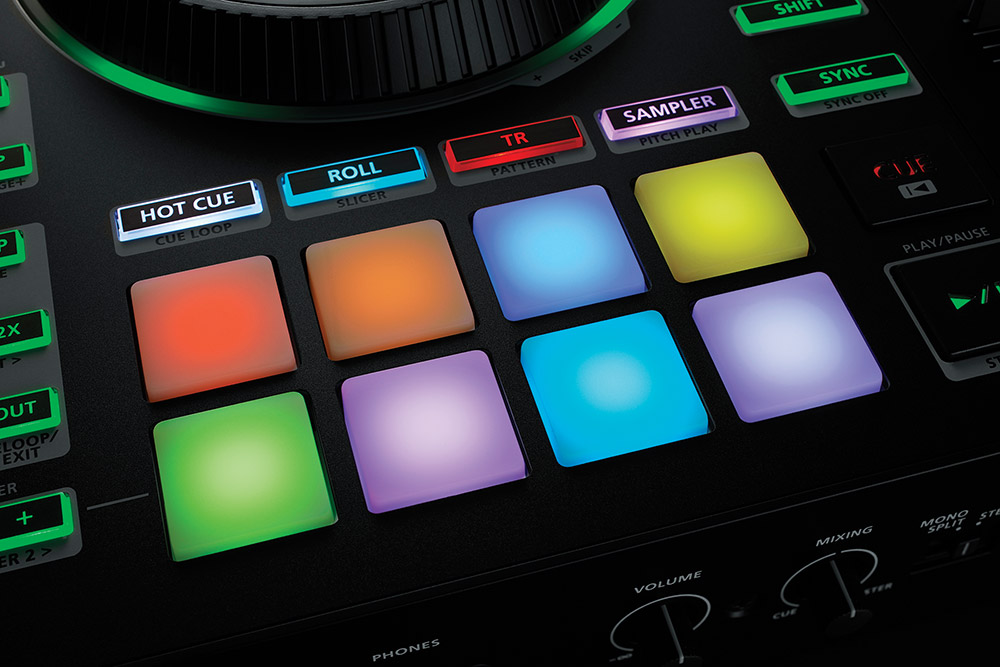
The DJ-808 also delivers über-flexible, pro-grade I/O—any of the four channels can be switched between PC (i.e., a Serato virtual deck), and then either line level input or phono level input (for two of them), or line level or USB input (the other two; more on those USB inputs later), letting you easily hook up external signal sources to augment your digital ones. You get front panel headphone jacks in both sizes, and on the back, the flexibility of booth outputs, and master outputs with both XLR and ¼-inch combo, as well as RCA options. There’s also a mic input (also in XLR and ¼-inch combo).
I also appreciate the fact that the DJ-808 can be used standalone—in other words, without Serato, or a computer. That extends it utility, of course, but much of the power of the unit is best realized when paired with Serato.
Well Beyond the Basics: The DJ-808 would make a pretty decent DJ controller if they’d stopped the design process at this point in my walk-through, but they didn’t.
On the DJ-centric side of things, buttons on both the left and right edges let you control Serato’s aforementioned Pitch ’N Time DJ Expansion Pack (P’NT DJ) capabilities. P’NT DJ brings superior time stretching and key shifting capabilities to Serato, letting you tinker with tracks at margins that just aren’t possible otherwise, opening up new creative power in the process.
But it’s along the top portion that you’ll find all the buttons and knobs for the features that make the DJ-808 so special, and blur the lines between “DJ” and “performing musician” in ways I’ve just not seen before.
First, the TR-S section provides a full 16-step sequencer that lets you program rhythms that use the sounds of Roland’s renowned drum machines, the TR-909, -808, -707 and -606. Programming beats is straightforward, and if you’re familiar with these or other drum machines, the concepts largely carry forward to the DJ-808 with ease. For everyone else, a quick read of the manual will get you on your way in minutes. The TR-S has its own fader in the middle, between the two pairs of regular channel faders.
The TR-S also offers independent faders for the four key rhythmic elements: bass, snare, and open and closed hats, allowing real-time performance control. You also get controls to tweak elements like the attack curve. Needless to say, with the range of sounds provided on board, along with the capability to use the sequencer to trigger samples loaded into Serato, you can go into some interesting territory, creatively speaking.
Second, you’ll find the VT (Vocal Transformer) section, which provides real-time effects to the signal of the microphone input, allowing you to adjust both the pitch and the formant characteristics of your voice—live. I was perhaps not quite as impressed with the VT feature as I was with the TR-S, but I can see its potential for certain styles and situations.
With the range of sounds provided on board, along with the capability to use the sequencer to trigger samples loaded into Serato, you can go into some interesting territory, creatively speaking.
Where I think things get even more interesting with the DJ-808 can be partially attributed to Roland, and are unique to the hardware, and partially can be attributed to new capabilities in Serato itself. Both have the same aim: Allow a DJ, using the DJ-808 and Serato, to perform live with external music creation hardware and/or software—either under the control of the DJ, or other performers.
On the Roland side, the company has integrated a couple of things:
First, MIDI out. Various actions on the DJ-808 output MIDI messages as you might expect (in ways that appear to be undocumented presently), but of interest here is that the DJ-808 can be a MIDI clock master or slave. While not particularly sophisticated, MIDI clock can be used to keep the unit in-tempo with companion hardware, at least in its rudimentary way.
Second, AIRA Link. AIRA is Roland’s secondary brand name for a family of interoperable products, and I have to say this is the most poorly documented and poorly described aspect of the DJ-808; in fact, I could find literally nothing about it other than a statement on the box—and on the Roland web site—that it was supported. (It’s not even mentioned in the manuals.) While Roland has a web microsite for AIRA, it’s not very helpful to really grasping the “whats” and “whys.” It seems as if Roland has followed other tech companies down the rabbit hole of applying a single name (AIRA) to a range of things that are only loosely related. One of those “things” is AIRA Link, which is plug-and-play.
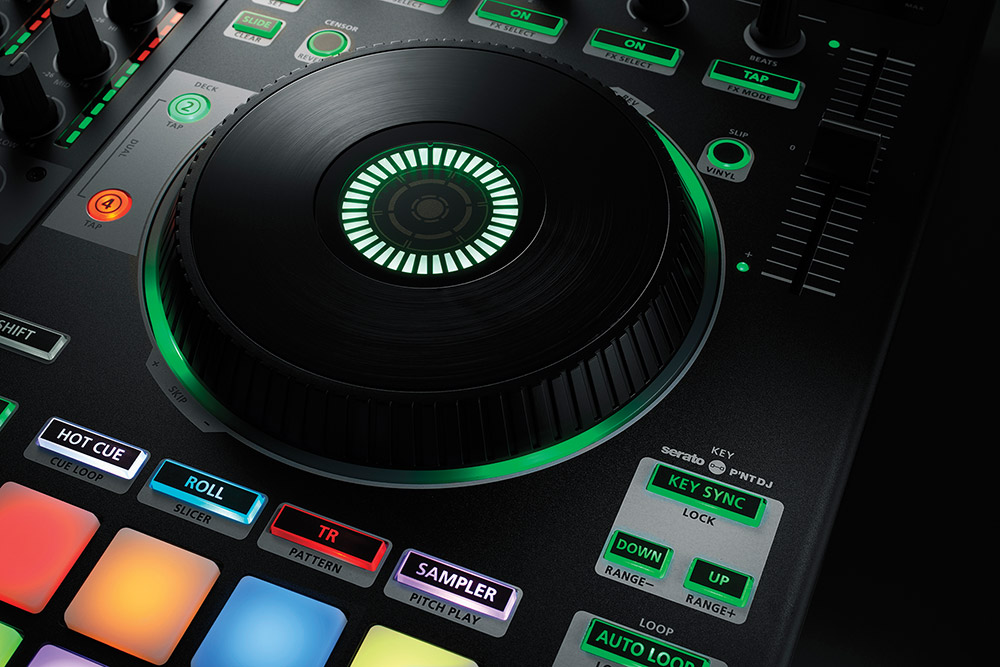
AIRA Link allows the use of a standard USB cable to connect multiple compatible devices, which can then share digital audio, MIDI, time sync, and bus power between them. On the DJ-808, the two aforementioned USB inputs are set aside for AIRA Link connections, which currently includes Roland products such as the TB-3 bass machine and various synths including the SYSTEM-1, among others. In this respect, the DJ-808 echoes the capabilities of Roland’s MX-1 “AIRA” mixer. Keep in mind that AIRA Link is (at least at the present time) proprietary, so don’t look for non-Roland products to function with the two provided USB ports.
To evaluate the AIRA Link functionality, I connected a Roland TB-3 to one of the ports, changing the front panel switch to use the USB input for the corresponding channel on the DJ-808. Pressing the “start” button in the DJ-808’s TR-S section, the programmed drum pattern started to play—and so did the currently-loaded bass pattern on the TB-3, in perfect sync, and with the same beat offsets on the respective step sequencers. Meanwhile, I starting mixing in a couple of tracks in Serato, looping some sections of each, while manipulating effects on the Serato side, while adjusting effects and envelopes on the TB-3. The creative potential here is very easy to see.
That potential starts to increase even more exponentially on the Serato side of the equation, due to the company’s recent announcement of support for Ableton Link. This innovative technology—supported in Ableton’s own DAW, Live, but also available via open source libraries to other developers—is designed to support network-based synchronization of tempo, beat, and phase. Link allows performers using either iOS devices running Link-compatible apps, or computers running Link-compatible music software, to perform together in a flexible manner that echoes the way that traditional musicians have been doing it for eons. I won’t bore you with the technical minutia behind Link—I will say it’s a novel and effective approach to the multi-electronic-musician synchronization problem, and apparently sufficiently novel and effective that it was adopted by Ableton’s competitor, Propellerhead, in Reason 9. It’s also been embraced in a growing number of iOS apps as well.
With Serato’s support for Link, it’s possible to have a full-blown DAW on the stage alongside the DJ-808 and Serato—with all the innovative capabilities that that combo brings to the table—with everything running in perfect sync. It’s not singular either; multiple DAWs, and/or a mix of iOS devices running compatible music apps can all be part of the performance as well, effortlessly joining or leaving the session. The possibilities are a bit mind-boggling, frankly. I tested Link by running Serato and the DJ-808 on one computer, with Ableton Live running on another, and even extended the clock synchronization to my Prophet 6 synth from Ableton Live via MIDI Clock. I’m pretty sure a little smoke was coming out of my ears as I considered the possibilities while I tinkered with the setup. Impressive.
Conclusions: With so much power provided by the DJ-808 itself to stretch the art of DJing into completely new territory through the integration of the TR-S and VT functionality, coupled with the software power and Link support of Serato, the net-net of this combo is empowering a DJ to explore new creative territory on his or her own—or to be a true part of an ensemble of stage performers with the exponential boost in creative potential that those synergies can bring.
Of course, let’s not forget that the DJ-808 + Serato is a pretty powerful combo for even the most ordinary of DJ activities, with all the connectivity, functionality and quality you’d expect from a truly professional DJ controller and DJ application.
With a street price in the neighborhood of $1,500, the Roland DJ-808 is no small investment, and its raw power will likely appeal to a particular echelon of DJ for whom the price is not a significant barrier to entry.
But it’s worth considering for many types of DJs, and regardless, it definitely blazes wholly new trails among DJ controllers. I’m sure it’s going to be turning the heads of many a DJ, and I, for one, can’t wait to see what people do with the power it offers.
Check out the Roland DJ-808 site here.
The Roland DJ-808 details:
- Built-in Roland TR drum machine with 606, 707, 808, 909 kicks, snares, claps and hi-hats
- Control the Serato Sampler with the TR-S sequencer
- Built-in VT Voice Transformer with Pitch, Formant, Ducking and Serato key matching
- Velocity sensitive RGB color pads for HOT CUE, ROLL, TR, SAMPLER and more
- Large ultra-low-latency platters with integrated displays
- 4 high-quality integrated Channel FX
- Standalone professional 4 channel digital mixer
- Connect external instruments via MIDI or AIRA Link USB and jam along with Serato DJ Pro
- 24bit/96kHz audio fidelity
- Control two decks simultaneously with dual deck mode
- 100mm pitch faders
- Unlocks Serato DJ Pro and comes with a Serato Pitch ‘n Time DJ license
- Connect turntables or CDJs with the purchase of a Serato DVS license





